NASA is considering sending two WB-57F research planes to chase the space shuttle when it launches at night to watch for trouble. Ground cameras can’t see the shuttle clearly at night because of the bright glow from the solid rocket boosters. NASA is also modernizing its current imaging systems, spending $3.2 million on new computers, software and cameras – they’re adding at least 11 new cameras at various places around the Kennedy Space Center.
China Finally Reveals Launch Plans
After years of secrecy, the Chinese government has finally revealed details of its upcoming launch. As predicted by media and industry insiders, Shenzhou 5 will launch some time between October 15 and 17. The flight will last between 14 orbits, or 21 hours – not the single orbit previously reported. They revealed that there are three astronaut candidates at the launch facility, but not the number that will actually ride in the spacecraft on this first flight.
Four New Space-Related Bills Passed
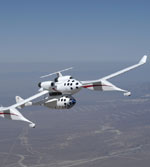
Image credit: Scaled Composites
The US government passed four new bills by voice vote that promote space and astronomy. The Commercial Space Act of 2003 hopes to better regulate commercial space launches, such as sub-orbital tourist flights. The Charles `Pete’ Conrad Astronomy Awards Act will encourage amateur astronomers to help spot potential Earth-crossing asteroids. The Remote Sensing Applications Act of 2003 will provide funding for satellite images to support various projects. And the Human Space Flight Independent Investigation Commission Act of 2003 will establish and independent commission to investigate future disasters, like the loss of Columbia.
The House Science Subcommittee on Space and Aeronautics today approved four bills by voice vote, listed below.
H.R. 3245, “Commercial Space Act of 2003,” sponsored by Rep. Dana Rohrabacher (R-CA)
This bill clarifies the legislative framework for commercial human space flight. Currently, the Federal Aviation Administration (FAA) Office of Space Transportation (AST) regulates U.S. commercial space launches for television, telecommunications and imagery satellites. H.R. 3245 ensures that commercial launchers – such as those being built by entrepreneurs to take people to the edge of space – would also be regulated by AST.
Last July, the Space & Aeronautics Subcommittee held a joint hearing with the Senate Commerce Committee on the regulatory issues facing such commercial human space. All of the witnesses at that hearing called for legislation to clearly define the FAA’s regulatory responsibilities on this issue.
“I believe that most Members of Congress share my view that the aerospace industry plays a critical role in advancing America’s space frontier,” said Subcommittee Chairman Rohrabacher. “This bill tells the Department of Transportation that this new commercial human space flight industry should be nurtured by streamlined and careful regulation”
The bill authorizes $11,523,000 and $11,000,000 for fiscal years 2004 and 2005, respectively, for the AST. The bill also authorizes $1,800,000 and $2,000,000 for fiscal years 2004 and 2005, respectively, for the Department of Commerce’s Office of Space Commerce, and delegates licensing authority for private-sector remote sensing systems to this Office.
H.R. 912, “Charles `Pete’ Conrad Astronomy Awards Act,” sponsored by Rep. Dana Rohrabacher (R-CA)
The Charles “Pete” Conrad Astronomy Awards Act, named for the third man to walk on the moon, establishes awards to encourage amateur astronomers to discover and track asteroids crossing in a near-Earth orbit. Earth has experienced several near-misses with asteroids that would have proven catastrophic, and the scientific community relies heavily on amateur astronomers to discover and track these objects. The bill authorizes $10,000 for each of fiscal years 2004 and 2005 for NASA to administer the program. The House approved the bill by voice vote last year.
“Pete Conrad was a pilot, explorer, and entrepreneur of the highest caliber. I think it is fitting that we honor Pete Conrad by establishing this award to encourage amateur astronomers and private citizens to keep looking up and out into the future,” said Rohrabacher.
H.R. 1292, “Remote Sensing Applications Act of 2003,” sponsored by Rep. Mark Udall (D-CO)
The Remote Sensing Applications Act, also approved by the House last year, will establish a grant program to help integrate remote sensing data to address state, local and regional needs. The U.S. already collects an abundant amount of remote sensing data, but it is often used only for scientific ventures. However, it can have countless local applications including urban planning, coastal zone management, resource supervision and disaster monitoring for state and local authorities. The bill authorizes $15,000,000 for each of the fiscal years 2004 through 2008 for NASA to carry out this program.
“The Remote Sensing Applications Act gives state and local governments 21st century tools to deal with 21st century challenges. My bill will help begin to bridge the gap between established and emerging technology solutions and the problems and challenges we face regarding growth management, homeland security, forest fire management and other issues,” said Udall. “I am pleased the Subcommittee passed the bill today, and hope the full Committee will soon follow suit.”
H.R. 2450, “Human Space Flight Independent Investigation Commission Act of 2003,” sponsored by Rep. Bart Gordon (D-TN)
H.R. 2450 would establish an independent, Presidentially-appointed investigative Commission in the event of incidents in the nation’s human space flight program that result in loss of crew, passengers, or spacecraft, including the International Space Station.
The Commission will consist of 15 members, to include the Chairman of the NTSB and 14 members appointed by the President and drawn in part from lists of candidates from the Majority and Minority Leaders of the Senate, and the Speaker and the Minority Leader of the House of Representatives. Except for the Chairman of the NTSB, no officer or employee of the Federal Government would serve as a member of the Commission.
Subcommittee Ranking Democrat Gordon said, “I appreciate the subcommittee’s support for this legislation, which provides for an independent and accountable accident investigation commission if, God forbid, we have another mishap in space. I hope the rest of my colleagues in the full Science Committee will act quickly to get this bill enacted into law.”
The Subcommittee accepted an amendment offered by Chairman Rohrabacher, clarifying that only those incidents involving missions carrying out U.S. Government activities would trigger the Presidentially-appointed Commission.
Original Source: House Committee on Science News Release
NASA Working on a Solution to Repair Shuttles
NASA gave a progress update this week on how their safety improvements to the space shuttle are going. It turns out, a $.99 foam brush does the best job of applying a special patch material that the astronauts can use to repair the shuttle’s heat tiles. They’re also working on ways to get better photos of the shuttle as it launches – even at night; currently the shuttle’s exhaust is too bright at night to really see the vehicle well enough to spot problems. The space shuttle Atlantis will likely be the next to launch, some time in September 2004.
NASA Moves Forward with Supersonic Airplane
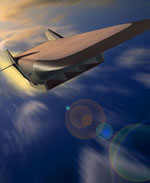
Image credit: NASA
NASA has picked Allied Aerospace to continue the development of its X-34C experimental aircraft. The $150 million contract will have Allied create three flight-ready demonstrator vehicles that will fly more than 8,000 kilometres per hour; or seven times the speed of sound. The vehicle is intended to demonstrate a working scramjet engine, which pulls part of its fuel from the air – making it smaller and more efficient. The demonstration aircraft will be launched atop a Pegasus rocked and raised to Mach 5; then they’ll disengage and speed up to Mach 7 under their own power.
NASA has selected Allied Aerospace Industries of Tullahoma, Tenn., to provide three flight-ready experimental demonstrator vehicles that will fly approximately 5,000 miles per hour or seven times the speed of sound. The multi-year project, called X-43C, will expand the hypersonic flight envelope for air-breathing engines.
The cost-plus-fixed-fee completion type contract carries performance incentives and is valued at nearly $150 million over 66 months. The base activity covers all work through completion of the Preliminary Design Review, and the optional effort covers the final design, hardware fabrication and all associated support activities.
The X-43C is the next logical step, following the Hyper-X (X-43A), vehicle that aims at demonstrating short duration scramjet powered flight at Mach 7 and Mach 10. The X-43C will demonstrate free flight of a scramjet-powered vehicle with acceleration capability from Mach 5 to Mach 7, as well as operation of a hydrocarbon fuel-cooled scramjet.
NASA’s Langley Research Center (LaRC), Hampton, Va. is leading a combined U.S. Air Force/industry team in the design and development of the X-43C demonstrator vehicle and its propulsion system. The engine, which will be provided by the Air Force, will be a dual-mode scramjet capable of running as a ramjet or scramjet.
Allied Aerospace, Flight Systems Division, will team with Pratt & Whitney, West Palm Beach, Fla.; Boeing Phantom Works, Huntington Beach, Calif.; and RJK Technologies, Blacksburg, Va.
Work will be performed primarily in Tullahoma and West Palm Beach. Some contract work will also take place at Huntington Beach, Blacksburg, St. Louis, LaRC and NASA’s Dryden Flight Research Center (DFRC), Edwards, Calif.
Future air-breathing space access vehicles offer advantages over conventional rocket-powered vehicles that must carry all of the oxidizer needed to burn their fuel. Air-breathing engine-powered vehicles obtain oxygen from the atmosphere in flight. By minimizing the need to carry oxidizer, smaller and more efficient vehicles can be designed for space access missions.
‘When fully developed, these advanced propulsion systems will offer increased safety, payload capacity and economy of operation for future, reusable space access vehicles,” said Paul Moses, manager of the X-43C project. “The X-43C project will validate advanced technologies, design tools and test techniques that will enable design of such vehicles in the future,” he said.
For the three demonstration flights, a Pegasus-derived rocket booster will be air-launched by a carrier aircraft to boost the X-43C demonstrator vehicles to Mach 5 at approximately 80,000 feet. The X-43C will separate from the booster and continue to accelerate to Mach 7 under its own power and autonomous control.
Flights will originate from DFRC. Flight paths of the vehicles will be over water within the Pacific Test Range.
Original Source: NASA News Release
Canada Joins Galileo System
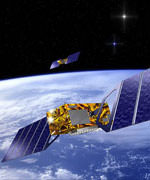
Image credit: ESA
The Canadian Space Agency announced today that it will be contributing to the development of Galileo, the space-based navigation system being created by the European Space Agency – similar to the US Global Positioning System. Canada will contribute $11 million which will open up the development stage of the project to accept bids from Canadian contractors. China announced a similar commitment last month. Galileo is expected to be fully operational by 2008.
Canada’s space industry will directly benefit from an Arrangement signed yesterday between the Canadian Space Agency (CSA) and the European Space Agency (ESA) that ensures Canada’s participation in the Development and Validation Phase of Europe’s Galileo Program.
Galileo is a European satellite navigation and positioning system that will provide highly accurate global positioning services. The CSA’s $11 million contribution to this phase of Galileo allows Canadian companies to respond to requests for proposals and to take an active part in the program.
“By collaborating with ESA in this leading-edge international satellite navigation initiative, Canada is targeting its funding to provide new and exciting opportunities for the Canadian space industry,” said Allan Rock, Minister of Industry and Minister responsible for the CSA.
Galileo is a joint initiative of the European Commission and ESA. It will be the first satellite positioning and navigation system intended specifically for civilian purposes and it will improve the reliability and availability of navigation and positioning services worldwide. When fully deployed in 2008, Galileo will employ up to 30 satellites in medium earth orbit, and will be supported by a worldwide network of ground stations. The Development and Validation Phase will take place from 2003 to 2006.
“Galileo’s new generation of navigation services will also benefit Canadians in such areas as air and sea traffic control, ground transportation, crime prevention, urban planning, agriculture and fisheries,” said Marc Garneau, President of the CSA.
The Arrangement was signed yesterday in Paris by Raymond Chr?tien, Canada’s Ambassador to France, on behalf of the Government of Canada, and by Jean-Jacques Dordain, ESA’s Director General.
About Canada and ESA
The European Space Agency (ESA) is composed of 15 Member States. Canada is a Cooperating Member and the only non-European country to participate directly in earth observation, telecommunications, navigation, exploration and technology development programs of ESA. Under the terms of the Canada-ESA Cooperation Agreement, CSA’s contributions to ESA programs are returned in the form of contracts to Canadian industry. The year 2004 will mark the 25th anniversary of Canada-ESA collaboration.
About the Canadian Space Agency
Established in 1989 with its Headquarters situated in Longueuil, Quebec, the CSA is responsible for the overall national program. The CSA delivers services relating to Earth and the Environment, Space Science, Human Presence in Space, Satellite Communications, Space Technology, Space Qualification Services, Space Awareness and Education. The CSA is at the forefront of the development and application of space knowledge for the benefit of Canadians and humanity.
Original Source: CSA News Release
Searching for Moons Around Distant Planets
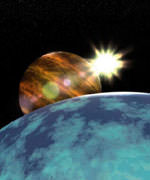
Image credit: ESA
The European Space Agency is working on a new mission that could be able to detect moons orbiting planets in other star systems. In 2008, the ESA will launch Eddington, which will detect the drop in light as planets as small as Mars pass in front of their parent stars. Astronomers should theoretically be able to detect moons going around those planets because of their gravity – if the planet dims the star a few minutes earlier or later than expected, it will have one or more moons.
ESA is now planning a mission that can detect moons around planets outside our Solar System, those orbiting other stars.
Everyone knows our Moon: lovers stare at it, wolves howl at it, and ESA recently sent SMART-1 to study it. But there are over a hundred other moons in our Solar System, each a world in its own right.
A moon is a natural body that travels around a planet. Moons are a by-product of planetary formation and can range in size from small asteroid-sized bodies of a few kilometres in diameter to several thousand kilometres, larger even than the planets Mercury and Pluto.
Landing on another moon
One such large moon is Titan, the target for ESA?s daring Huygens mission that in 2005 will become the first spacecraft ever to land on a moon of another planet. Titan is slightly bigger than the planet Mercury, and is only called a moon because it orbits the giant planet Saturn rather than the Sun.
Four other large moons can be found around another of our neighbours, Jupiter. These are Io, Europa, Ganymede and Callisto. Europa has captured attention because beneath its icy surface, scientists think that an ocean covers the entire moon. Some scientists have even speculated that microscopic life might be found in that ocean.
Habitable moons?
In 2008, ESA plans to launch its ?rocky planet? finder Eddington. By detecting the drop in light seen when a world passes in front of its parent star, Eddington will be capable of discovering planets the size of Jupiter, and also those smaller than Mars.
That means, if our own Solar System is anything to go by, it will be capable of detecting moons similar in size to Titan and the four large moons of Jupiter.
It would be particularly exciting if such combinations of planets and moons were found orbiting a star at Earth?s distance from the Sun. Perhaps then the surfaces of the moons would be warmed to habitable levels.
Orbital dancing
What about moons similar to our own? An equivalent of Earth?s moon would be too small to be detected directly by Eddington, but such a body would affect the way its planet moves and it is that movement which Eddington could detect.
The Earth and the Moon orbit the Sun like ballroom dancers who move around the floor, simultaneously twirling about one another. This means the Earth does not follow a strictly circular path through space, sometimes it will be leading the Moon and sometimes trailing.
This causes variations of up to five minutes from where the Earth would be if it did not possess a moon. By precisely timing when a rocky planet passes in front of its star, Eddington will be able to show if a moon is pulling its planet out of a strictly circular path around the star.
So, how many moons can Eddington expect to find circling planets around other stars? If we make an estimate based on our own Solar System, several thousands will be found ? however, no one knows for sure. That?s what makes the quest so exciting!
Original Source: ESA News Release
Keck Uses Adaptive Optics for the First Time
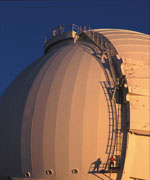
Image credit:: Keck
The 10-metre Keck II observatory took an important step forward recently when it began observations with its new adaptive optics system. The system uses a laser to create a fake star about 90 kilometres up in the sky – a computer can then use this to calculate how to remove the effect of atmospheric disturbances. Adaptive optics have been used on smaller telescopes, but this is the first time it’s been employed on a telescope as large as the mighty Keck II; it took nine years to adapt the observatory.
A major milestone in astronomical history took place recently at the W.M. Keck Observatory when scientists, for the first time, used a laser to create an artificial guide star on the Keck II 10-meter telescope to correct the blurring of a star with adaptive optics (AO). Laser guide stars have been used on smaller telescopes, but this is their first successful use on the current generation of the world’s largest telescopes. The resulting image (Figure 1), captured by the NIRC2 infrared camera, was the first demonstration of a laser guide star adaptive optics (LGS AO) system on a large telescope. When complete, the LGS AO system will mark a new era of astronomy in which astronomers will be able to see virtually any object in the sky with the clarity of adaptive optics.
“This is one of the most gratifying moments in all my years at Keck,” remarked Dr. Frederic Chaffee, director of the W.M. Keck Observatory the evening the observations were made. “Like any positive first light result, there is much to be done before the system can be considered operational. But also like any positive first light result, it shows that it can be done, and gives us great optimism that our goals are not impossible dreams, but are instead attainable realities.”
Adaptive optics is a technique that has revolutionized ground-based astronomy through its ability to remove the blurring of starlight caused by the earth?s atmosphere. Its requirement of a relatively bright “guide star” in the same field of view as the scientific object of study has generally limited the use of AO to about one percent of the objects in the sky.
To overcome this restriction, in 1994 the W.M. Keck Observatory began working with Lawrence Livermore National Labs (LLNL) to develop an artificial guide star system. By using a laser to create a ?virtual star,? astronomers can study any object in the vicinity of much fainter (up to 19th magnitude) objects with adaptive optics and reduce its dependence on bright, naturally occurring guide stars. Doing so will increase sky coverage for the Keck adaptive optics system from an estimated one percent of all objects in the sky, to more than 80 percent.
“This new capability of using a laser guide star with a large telescope has invited astronomers to start exploring the night sky in a much more comprehensive manner,” said Adam Contos, optics engineer at the W.M. Keck Observatory. “In the future, I would expect most major observatories to be installing similar systems to take advantage of this incredible enhancement to their AO capabilities.”
In January 2001, after more than seven years in development, the Keck and LLNL teams celebrated the completion of the Keck laser guide star system. The artificial star results when light from a 15-watt dye laser causes a naturally occurring layer of sodium atoms to glow about 90 km (56 miles) above the earth’s surface. It would take another two years of sophisticated research and design before the laser system could be integrated into the Keck II adaptive optics system.
In the early morning hours of September 20th, all subsystems finally came together to reveal the unique capability of the Keck LGS AO system and its potential to resolve extremely faint objects. The system locked on a 15th magnitude star, a member of a well-known T Tauri binary called HK Tau and revealed details of the circumstellar disk of the companion star. It was the first time an adaptive optics system on a very large telescope had ever used an artificial guide star to resolve a faint object.
A key challenge the LGS AO team faced was how successful the efforts would be to integrate and achieve good performance measurements for each required sub-system. Concerns about the power of the laser and its spot quality, operation of the laser traffic control system, the ability of the new sensors to lock on fainter guide stars, and being able to optimize the image quality through an accurate understanding of the aberrations that could not be measured by using the laser guide star, were all factored into the evening’s observing.
“First light was a superb team effort,” said Dr. Peter Wizinowich, team leader for the adaptive optics team at W.M. Keck Observatory. “It was very satisfying to have each of the many subsystems perform so well on our first attempt. To quote Virgil, ‘Audentes Fortuna Juvat,’ fortune favors the bold.”
The quality of the LGS AO first light images was extremely high. While locked on a 14th magnitude star, the Keck LGS AO system recorded “Strehl ratios” of 36 percent (at 2.1 micron wavelength, 30-second exposure time, Figure 3), compared to four percent for uncorrected images. Strehl ratios measure the degree to which an optical system approaches “diffraction-limited” perfection, or the theoretical performance limit, of the telescope.
Another performance metric, the “full width at half maximum” (FWHM), for this 14th magnitude star was 50 milli-arcseconds, compared to 183 milli-arcseconds for the uncorrected image. FWHM measurements help astronomers determine the actual edges of an object, where the detection may be imprecise or difficult to determine. The measurement of 50 milli-arcseconds is about equivalent to being able to distinguish a pair of car headlights in New York while standing in Los Angeles.
Throughout the evening, the laser guide star held steady and bright, shining at an approximate magnitude of 9.5, about 25 times fainter than what the human eye can see, but ideal for the Keck adaptive optics system to measure and correct for atmospheric distortions.
Additional work is underway before the Keck LGS AO system can be considered fully operational. The Keck LGS AO system will be available for limited shared risk science next year, with full deployment to the Keck user community in 2005.
“Even with just this first test, astronomers are already clamoring to use the laser guide star system to study distant galaxies with an unprecedented resolution and power,” said Dr. David Le Mignant, adaptive optics instrument scientist at the W.M. Keck Observatory, California Association for Research in Astronomy. “By next year, adaptive optics will be used to study the rich formation history of early galaxies.”
The importance of this breakthrough to worldwide astronomy was summed up by Dr. Matt Mountain, the director of the Gemini Observatory, which operates twin 8-meter telescopes, one on Mauna Kea and one on Cerro Pachon in Chile: “This is a critical milestone for all ground-based astronomy, not just for our current generation of eight to 10-meter class telescopes, but also for our dreams of 30-meter telescopes.”
Team members responsible for the Keck LGS AO system are Antonin Bouchez, Jason Chin, Adam Contos, Scott Hartman, Erik Johansson, Robert Lafon, David Le Mignant, Chris Neyman, Paul Stomski, Doug Summers, Marcos van Dam, and Peter Wizinowich, all from the W.M. Keck Observatory, California Association for Research in Astronomy. The team gave special thanks to their collaborators at LLNL: Dee Pennington, Curtis Brown and Pam Danforth.
The laser guide star adaptive optics system was funded by the W.M. Keck Foundation.
The W.M. Keck Observatory is operated by the California Association for Research in Astronomy, a scientific partnership of the California Institute of Technology.
Original Source: Keck News Release
More Chinese Launch Plans Emerging
News reports in China have stated that the Chinese are will attempt to join the nations capable of sending humans into space on October 15, a day after the meeting of Communist party members. The Shenzhou 5 spacecraft will carry a single astronaut (or yuhangyuan) into space for a single 90-minute loop around the Earth. It appears the Chinese are going to be very conservative on their first launch attempt, essentially matching the flight that Yuri Gagarin made more than 40 years ago. There hasn’t been an official launch announcement from the government yet.
Book Review: Hubble: The Mirror on the Universe
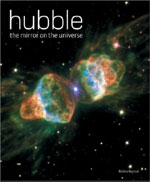
“Hubble: The Mirror on the Universe” by Robin Kerrod is the newest coffee table book filled with beautiful pictures from the Hubble Space Telescope. The 192-page hardcover contains hundreds of pictures, of objects as near as our solar system to the very edges of the Universe.
The book is categorized into different kinds of astronomical objects, so the chapters go like: Stars in the Firmament, Stellar Death and Destruction, etc. Each chapter is broken up into a collection of images from Hubble that relate to the topic, and then a nice description of what’s going on in the picture. Robin Kerrod is an accomplished astronomy writer (The Sky at Night, History of NASA, more) and it really helps to have a knowledgeable guide take you through the pictures. There are also plenty of full page, and even two-page spreads dedicated to some of the best pictures from Hubble.
The book was only published in September 2003, so its big advantage to all the other Hubble coffee table books is that it’s got the newest photos. I noticed some pictures that were only released a few months ago.
What surprised me when I read the book is that it’s really an overview of astronomy, using pictures from Hubble as a background to the descriptions. Instead of ignoring things that Hubble hasn’t taken pictures of, Kerrod included pictures from other sources other than Hubble – I think this was a wise move because it makes the book a more complete view of space and astronomy than a narrow view through the Hubble mirror.
The pictures are beautiful, no argument here – you’ll recognize many of them. And the text is comprehensive and well-written. There’s really good background information on the observatory itself; how it was built, launched, repaired and upgraded.
Although it was great to see additional text and pictures to make the book a more complete view of astronomy, the non-Hubble pictures aren’t clearly marked. Sometimes there’s a mention in the image caption, and there are image credits at the back of the book, but it would have been helpful if they stated it clearly beside the images. So, you can’t assume that every picture you’re looking at was actually taken by Hubble.
Here’s a link to more information from Amazon.com – Amazon.ca – Amazon.co.uk
